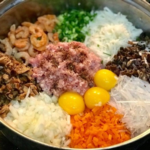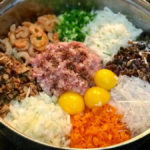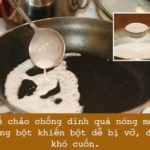Rice paper is an integral part of Vietnamese cuisine, featuring in dishes across the country. But how much do we really know about this versatile “bánh”? Let’s explore further in this article.
1. Understanding Rice Paper
What is rice paper?
Rice paper is a type of thin, dried sheet made primarily from rice flour. It is typically produced by mixing rice flour with water to form a batter, which is then cooked on a hot surface to create a thin, pliable sheet. This sheet is then dried, resulting in rice paper. When eaten, rice paper can be grilled to a crisp or dipped in water to make it pliable for rolling.
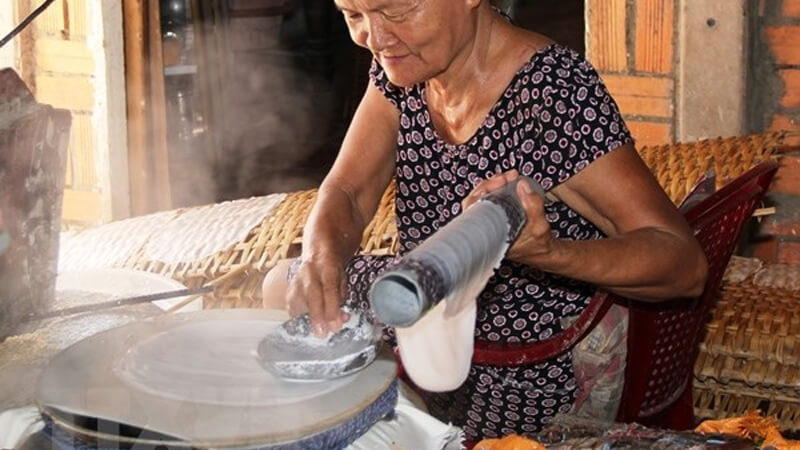 The rice paper-making process
The rice paper-making process
In Vietnamese cuisine, rice paper is also used as a wrapper for the famous gỏi cuốn, known as nem or bánh đa nem in the North.
Regional variations of rice paper
In different regions of Vietnam, rice paper goes by different names and exhibits slight variations:
In Southern Vietnam, it is commonly referred to as “bánh tráng,” derived from the process of “tráng” (coating) during its production.
 Drying rice paper
Drying rice paper
In some parts of Central Vietnam and North-Central Vietnam, rice paper may be made thicker and is known as “bánh đa.” Additionally, the term “bánh khô” is used for rice paper that is grilled and eaten directly. In contrast, the rice paper used for wrapping nem (bánh đa nem) is called “bánh chả,” as the fried spring rolls in this region are called “chả.”
 Bánh khô
Bánh khô
In Northern Vietnam, rice paper used to be called “bánh tráng,” similar to the South. However, during the reign of Lord Trịnh Tráng in the North, the name was changed to “bánh đa” to avoid using the lord’s name.
 Bánh đa
Bánh đa
2. Calorie Content of Rice Paper
White Rice Paper
 White Rice Paper
White Rice Paper
White rice paper is the most common type, made from rice flour with the possible addition of other flours for elasticity. On average, every 100 grams of white rice paper contains approximately 280-300 calories.
Mixed Rice Paper
 Mixed Rice Paper
Mixed Rice Paper
A popular snack among young people, mixed rice paper is made by adding various ingredients such as dried beef, eggs, dried shrimp, green mango, chili, and scallions. Depending on the added ingredients, the calorie content of mixed rice paper varies, with 100 grams providing around 300-330 calories.
Coconut Rice Paper
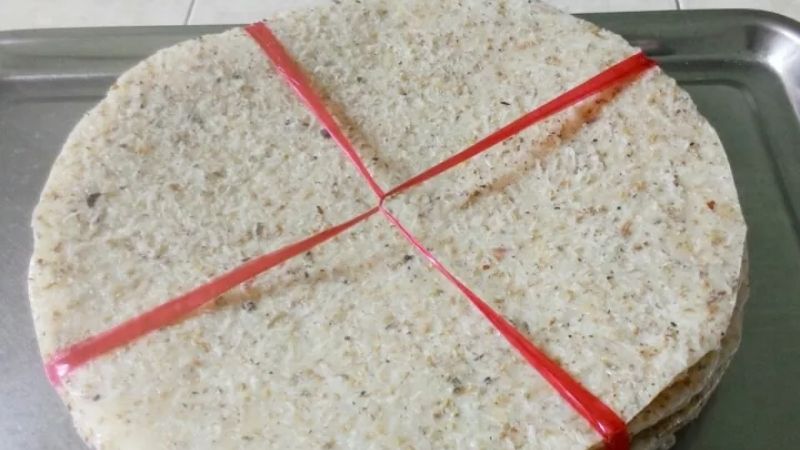 Coconut Rice Paper
Coconut Rice Paper
Originating from the Mekong Delta region, coconut rice paper is made by adding coconut milk to the rice paper batter, resulting in a richer and more aromatic flavor when grilled. A grilled coconut rice paper typically contains about 100 calories, making it a relatively low-calorie snack option.
Milk Rice Paper
 Milk Rice Paper
Milk Rice Paper
Milk rice paper, also known as coconut milk rice paper, is made from familiar ingredients such as rice flour, coconut milk, and cassava starch, along with aromatic ingredients like pandan leaves and durian. This snack is particularly popular in Southern Vietnam. Milk rice paper comes in two types: one that can be eaten directly and another that needs to be grilled. Each piece of milk rice paper contains approximately 75 calories, although this may vary depending on the ingredients used.
Brown Rice Paper
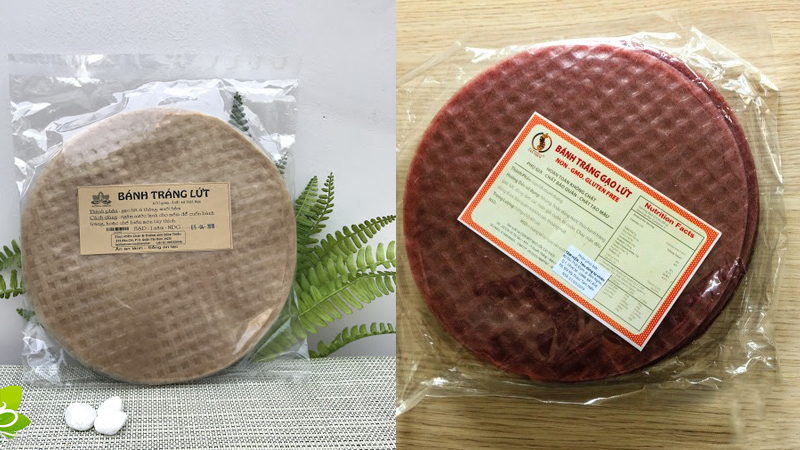 Brown Rice Paper
Brown Rice Paper
Brown rice paper is produced similarly to white rice paper, but with brown rice flour or ground brown rice as the main ingredient. According to some nutrition experts, the calorie content of brown rice paper ranges from 240-340 per 100 grams.
Grilled Rice Paper
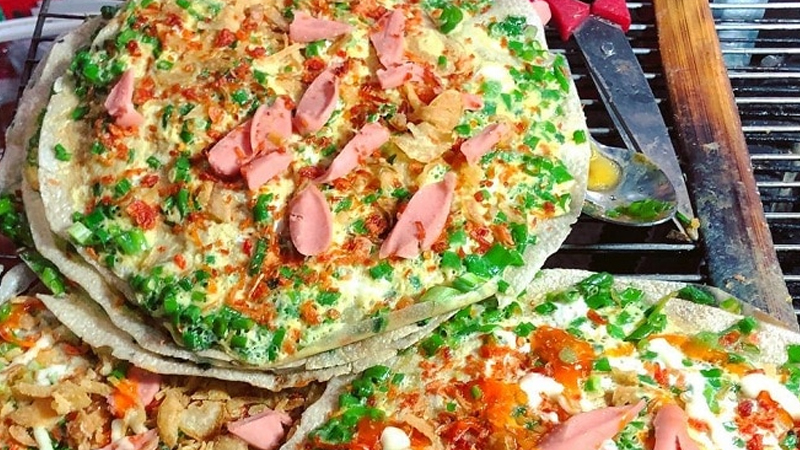 Grilled Rice Paper
Grilled Rice Paper
Grilled rice paper is a creative snack, often referred to as the “Vietnamese Pizza.” It can be made using either white or sesame rice paper, grilled over charcoal, and topped with various ingredients such as quail eggs, shredded chicken, dried shrimp, beef jerky, and ruốc (a type of Vietnamese pork paste). Due to the generous toppings, each grilled rice paper typically contains 300-360 calories, so it’s important to enjoy in moderation.
Rolled Rice Paper
 Rolled Rice Paper
Rolled Rice Paper
Rolled rice paper is made by wrapping white or shrimp rice paper around a filling of shredded green mango, eggs, and ruốc, and is typically served with a sweet and sour tamarind sauce and a chili sauce. Consequently, 100 grams of rolled rice paper contains approximately 300-400 calories, a relatively high amount.
Sesame Grilled Rice Paper
 Sesame Grilled Rice Paper
Sesame Grilled Rice Paper
Sesame grilled rice paper is made by sprinkling sesame seeds on regular white rice paper before grilling. On average, every 100 grams of sesame grilled rice paper contains 220-240 calories.
3. Nutritional Content of Rice Paper
The nutritional content of 100 grams of thin rice paper is as follows:
- Calories: 333
- Protein: 4g
- Carbohydrates: 78.9g
- Fat: 20mg
- Vitamin A: 30mcg
- Calcium: 200mg
- Phosphorus: 500mg
- Iron: 65mg
The nutritional content may vary depending on the additional ingredients used in the rice paper. For example, mixed rice paper with added green mango and herbs will have a higher fiber content than plain thin rice paper.
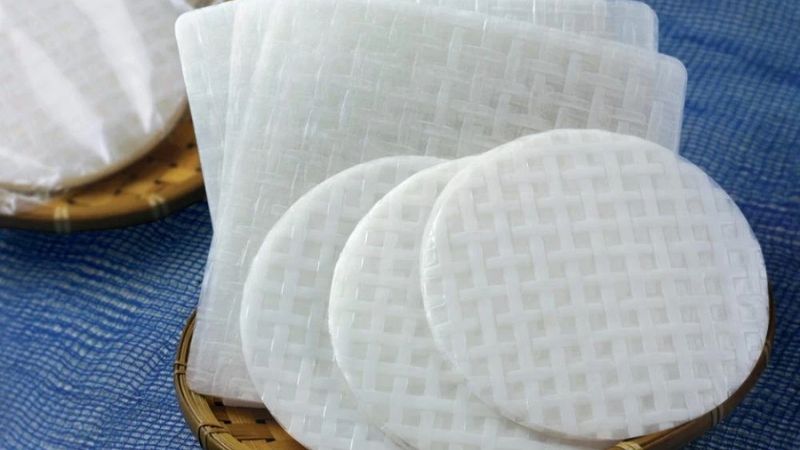 Nutritional content of thin rice paper
Nutritional content of thin rice paper
4. Benefits of Eating Rice Paper
White rice paper, with its moderate calorie content, can support weight loss when consumed as part of a balanced diet. However, it’s important to combine it with a variety of vegetables and fruits to ensure effective weight management.
 Eating rice paper can aid in weight loss
Eating rice paper can aid in weight loss
5. Does Eating Rice Paper Cause Weight Gain?
Whether eating rice paper leads to weight gain depends on the quantity consumed and the type of rice paper.
White Rice Paper
 Rice paper is naturally low in calories
Rice paper is naturally low in calories
While rice is calorie-dense, a single grain of rice can produce hundreds of rice paper sheets. Therefore, consuming a few sheets of rice paper contributes a negligible amount of calories to your diet, making it unlikely to cause weight gain.
Processed Rice Paper
For processed rice paper varieties like mixed, grilled, or rolled rice paper, the calorie content varies depending on the added ingredients and the quantity consumed. The more ingredients and the larger the portion size, the higher the calorie intake.
 Combine rice paper consumption with exercise for a healthy lifestyle
Combine rice paper consumption with exercise for a healthy lifestyle
To maintain a healthy weight, it’s important to consume rice paper in moderation, include plenty of vegetables and fruit in your diet, and engage in regular physical activity and exercise to burn off excess calories.
6. Is It Good to Eat a Lot of Rice Paper?
While rice paper is a convenient and tasty snack to curb hunger, excessive consumption may have negative effects on health. During production, rice paper is often treated with various additives to enhance its flavor, and these substances can potentially cause digestive issues, constipation, and put strain on the liver and kidneys.
 Excessive oil and chili in rice paper can contribute to acne
Excessive oil and chili in rice paper can contribute to acne
Additionally, the amount of rice paper one should consume varies depending on the type. It’s important to be mindful of the calorie content of different varieties and adjust your intake accordingly to avoid weight gain and overburdening your organs.
7. Tips for Eating Rice Paper to Lose Weight
Moderation is Key
According to experts, it’s recommended to consume a maximum of 100 grams of rice paper-based snacks at a time and to avoid eating them on consecutive days. This allows for proper digestion and prevents the accumulation of fat, thus supporting weight management.
Combine with Vegetables
You can use rice paper to create healthy snacks by wrapping it around vegetables, thereby increasing your fiber intake and aiding in weight loss.


























